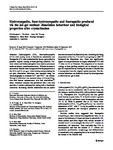Hydroxyapatite, fluor-hydroxyapatite and fluorapatite produced via the sol–gel method: dissolution behaviour and biological properties after crystallisation

Date
2014-01Author
Subject
Metadata
Show full item recordAbstract
Hydroxyapatite (HA), fluor-hydroxyapatite (FHA) with varying levels of fluoride ion substitution and fluorapatite (FA) were synthesised by the sol-gel method as possible implant coating or bone-grafting materials. Calcium nitrate and triethyl phosphite were used as precursors under an ethanol-water based solution. Different amounts of ammonium fluoride were incorporated for the preparation of the FHA and FA sol-gels. After heating and powdering the sol-gels, dissolution behaviour was assessed using ion chromatography to measure Ca(2+) and PO4 (3-) ion release. Biological behaviour was assessed using cellular proliferation with human osteosarcoma cells and alamarBlue™ assay. Statistical analysis was performed with a two way analysis of variance and post hoc testing with a Bonferroni correction. Increasing fluoride substitution into an apatite structure decreased the dissolution rate. Increasing the firing temperature of the HA, FHA and FA sol-gels up to 1,000 °C decreased the dissolution rate. There was significantly higher cellular proliferation on highly substituted FHA and FA than on HA or Titanium. The properties of an implant coating or bone grafting material can be tailored to meet specific requirements by altering the amount of fluoride that is incorporated into the original apatite structure. The dissolution behaviour can further be altered by the temperature at which the sol-gel is fired.
Collections
Publisher
Place of Publication
Journal
Volume
Issue
Pagination
Recommended, similar items
The following license files are associated with this item:

